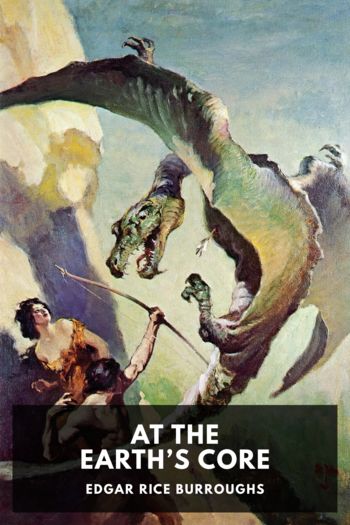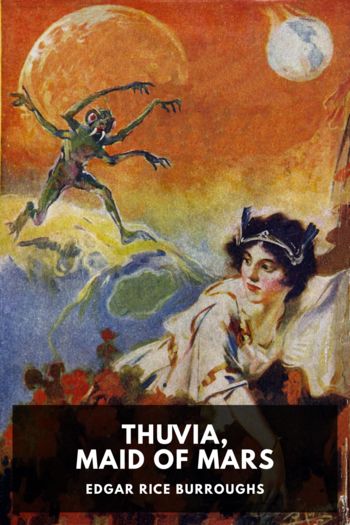Pellucidar by Edgar Rice Burroughs (read full novel .txt) 📕

Description
Pellucidar, the sequel to At the Earth’s Core, was published in 1915. It continues the adventures of David Innes as he returns to the hollow interior of the Earth in search of his friend Perry and his lost love Dian the Beautiful. He takes with him many tools and weapons, intent on bringing civilization to the savage world within, which is populated with dinosaurs and neolithic creatures. He has many perilous adventures as he battles to survive.
Read free book «Pellucidar by Edgar Rice Burroughs (read full novel .txt) 📕» - read online or download for free at americanlibrarybooks.com
- Author: Edgar Rice Burroughs
Read book online «Pellucidar by Edgar Rice Burroughs (read full novel .txt) 📕». Author - Edgar Rice Burroughs
There is a certain unwritten law of the arena that vouchsafes freedom and immunity to the victor, be he beast or human being—both of whom, by the way, are all the same to the Mahar. That is, they were accustomed to look upon man as a lower animal before Perry and I broke through the Pellucidarian crust, but I imagine that they were beginning to alter their views a trifle and to realize that in the gilak—their word for human being—they had a highly organized, reasoning being to contend with.
Be that as it may, the chances were that the tarag alone would profit by the law of the arena. A few more of his long strides, a prodigious leap, and he would be upon the girl. I raised a revolver and fired. The bullet struck him in the left hind leg. It couldn’t have damaged him much; but the report of the shot brought him around, facing me.
I think the snarling visage of a huge, enraged, saber-toothed tiger is one of the most terrible sights in the world. Especially if he be snarling at you and there be nothing between the two of you but bare sand.
Even as he faced me a little cry from the girl carried my eyes beyond the brute to her face. Hers was fastened upon me with an expression of incredulity that baffles description. There was both hope and horror in them, too.
“Dian!” I cried. “My Heavens, Dian!”
I saw her lips form the name David, as with raised javelin she rushed forward upon the tarag. She was a tigress then—a primitive savage female defending her loved one. Before she could reach the beast with her puny weapon, I fired again at the point where the tarag’s neck met his left shoulder. If I could get a bullet through there it might reach his heart. The bullet didn’t reach his heart, but it stopped him for an instant.
It was then that a strange thing happened. I heard a great hissing from the stands occupied by the Mahars, and as I glanced toward them I saw three mighty thipdars—the winged dragons that guard the queen, or, as Perry calls them, pterodactyls—rise swiftly from their rocks and dart lightning-like, toward the center of the arena. They are huge, powerful reptiles. One of them, with the advantage which his wings might give him, would easily be a match for a cave bear or a tarag.
These three, to my consternation, swooped down upon the tarag as he was gathering himself for a final charge upon me. They buried their talons in his back and lifted him bodily from the arena as if he had been a chicken in the clutches of a hawk.
What could it mean?
I was baffled for an explanation; but with the tarag gone I lost no time in hastening to Dian’s side. With a little cry of delight she threw herself into my arms. So lost were we in the ecstasy of reunion that neither of us—to this day—can tell what became of the tarag.
The first thing we were aware of was the presence of a body of Sagoths about us. Gruffly they commanded us to follow them. They led us from the arena and back through the streets of Phutra to the audience chamber in which I had been tried and sentenced. Here we found ourselves facing the same cold, cruel tribunal.
Again a Sagoth acted as interpreter. He explained that our lives had been spared because at the last moment Tu-al-sa had returned to Phutra, and seeing me in the arena had prevailed upon the queen to spare my life.
“Who is Tu-al-sa?” I asked.
“A Mahar whose last male ancestor was—ages ago—the last of the male rulers among the Mahars,” he replied.
“Why should she wish to have my life spared?”
He shrugged his shoulders and then repeated my question to the Mahar spokesman. When the latter had explained in the strange sign-language that passes for speech between the Mahars and their fighting men the Sagoth turned again to me:
“For a long time you had Tu-al-sa in your power,” he explained. “You might easily have killed her or abandoned her in a strange world—but you did neither. You did not harm her, and you brought her back with you to Pellucidar and set her free to return to Phutra. This is your reward.”
Now I understood. The Mahar who had been my involuntary companion upon my return to the outer world was Tu-al-sa. This was the first time that I had learned the lady’s name. I thanked fate that I had not left her upon the sands of the Sahara—or put a bullet in her, as I had been tempted to do. I was surprised to discover that gratitude was a characteristic of the dominant race of Pellucidar. I could never think of them as aught but cold-blooded, brainless reptiles, though Perry had devoted much time in explaining to me that owing to a strange freak of evolution among all the genera of the inner world, this species of the reptilia had advanced to a position quite analogous to that which man holds upon the outer crust.
He had often told me that there was every reason to believe from their writings, which





Comments (0)